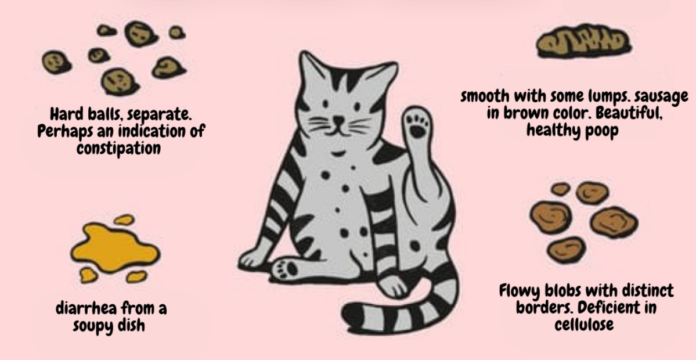As a responsible cat owner, monitoring your pet’s health goes beyond just ensuring they are eating well and staying active. One important but often overlooked indicator of a cat’s well-being is their poop. Paying attention to the color, consistency, and frequency of your cat’s stool can provide valuable insights into their overall health. In this article, we’ll explore a “cat poop chart” to help you better understand what’s normal, what’s not, and when to consult a vet.
advertisement
Table of Contents
1. What Is a Cat Poop Chart?
A cat poop chart is a simple tool that helps cat owners track and assess the appearance of their cat’s stool. The chart typically categorizes cat poop based on various characteristics like color, consistency, and frequency. Each of these factors can indicate different health conditions, from minor dietary issues to more serious medical problems.
By regularly observing your cat’s poop, you can detect early warning signs of digestive issues, infections, or other health concerns, allowing for quicker intervention and treatment.
2. Normal Cat Poop Characteristics
Before diving into the abnormalities, it’s important to know what healthy cat poop looks like.
- Color: Normal cat poop is usually a deep brown. This indicates that your cat’s digestive system is functioning properly.
- Consistency: The stool should be firm but not hard, with a well-formed log shape. It shouldn’t crumble when picked up, nor should it be overly sticky.
- Odor: While cat poop will never smell pleasant, extremely foul odors can be a sign of dietary problems or infections.
- Frequency: On average, a healthy cat should defecate at least once a day.
3. Cat Poop Color Chart
The color of your cat’s stool can be a quick and easy way to identify potential health issues. Here’s a breakdown of what different colors might mean:
- Brown: This is the ideal color for cat poop. It indicates that your cat’s digestive system is functioning normally, and there’s likely no cause for concern.
- Black or Very Dark Brown: Dark-colored stool can be a sign of internal bleeding in the upper gastrointestinal tract. It could also indicate that your cat is constipated or dehydrated. If you notice black poop, it’s essential to consult a vet immediately.
- Yellow: Yellow or pale stools can point to liver or gallbladder problems. This may indicate that your cat isn’t properly digesting food, and it requires veterinary attention as soon as possible.
- Green: Green poop can mean that your cat’s food is moving too quickly through the digestive system, not allowing for proper digestion. It could also indicate the ingestion of grass or plants. While it might not always be a cause for concern, it’s a good idea to monitor your cat closely.
- Red or Bloody: Blood in the stool is always a red flag. Bright red blood can indicate bleeding in the lower gastrointestinal tract, while darker blood could signify internal bleeding. Either way, this requires immediate veterinary attention.
- White or Gray: White or gray stools are uncommon but could indicate issues with the bile duct or liver. This warrants a veterinary check-up.
advertisement
4. Cat Poop Consistency Chart
Stool consistency is another important factor in assessing your cat’s health. Here’s what different textures could mean:
- Firm and Well-Formed: This is the ideal consistency for cat poop. It means your cat’s digestive system is in good health, and their diet is well-balanced.
- Soft, but Still Formed: This may be a sign of minor digestive upset, perhaps due to a change in diet or stress. It’s not usually a cause for concern unless it persists.
- Mushy or Watery: Diarrhea is a common issue in cats and can result from anything from dietary intolerance to infection. Persistent diarrhea can lead to dehydration and should be addressed by a vet if it lasts more than a day or two.
- Hard and Dry: Hard, dry poop often indicates constipation, which can be caused by dehydration, lack of fiber, or other health issues. Make sure your cat is drinking enough water and consider adding more fiber to their diet.
- Slimy or Coated in Mucus: Mucus-covered stools may suggest inflammation in the colon or gastrointestinal tract. This should be checked by a veterinarian if it continues over several bowel movements.
5. When to Contact a Vet
While occasional changes in your cat’s stool might not always signal a serious problem, consistent abnormalities warrant professional attention. Contact your veterinarian if you notice any of the following:
- Persistent diarrhea or constipation
- Blood in the stool
- Sudden changes in color
- Severe or lasting changes in consistency
- Changes in frequency (e.g., not pooping for days)
6. What Affects Cat Poop?
Several factors can influence your cat’s bowel movements:
advertisement
- Diet: A sudden change in diet, food allergies, or intolerances can cause digestive upset. Make sure to transition to new food gradually.
- Hydration: Dehydration can lead to constipation and hard stools.
- Stress: Stressful events like moving or the introduction of a new pet can impact your cat’s digestive system.
- Medical Conditions: Parasites, infections, and chronic illnesses can all cause changes in your cat’s poop.
Conclusion
Monitoring your cat’s poop is a simple yet effective way to keep an eye on their overall health. By using a cat poop chart, you can easily identify abnormalities in color, consistency, and frequency that might indicate health issues. Regularly cleaning the litter box and paying attention to any changes in your cat’s stool can help ensure early detection of potential problems, allowing for prompt veterinary care when needed.

